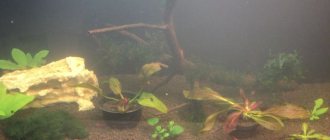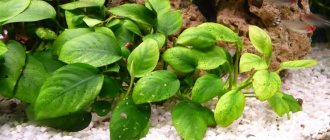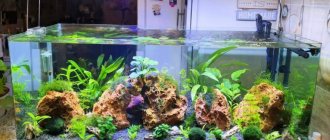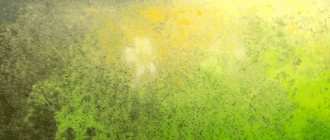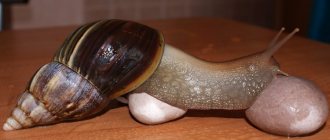Why is it dangerous?
Yellow water itself is not dangerous for fish or shrimp.
But this is a signal that there are problems in the aquarium. But the causes of this problem can be dangerous to the life of aquatic organisms.
Therefore, in case of yellowing water, the most important thing is to determine the cause and try to correct the situation without resorting to restarting the aquarium.
Yellow water reduces the water throughput, and the light illuminates the plants less well, their growth slows down. Particularly sensitive plants (ericaulons, ground cover, tonina) may die in such conditions.
Before sounding the alarm, it is important to understand whether the water is really yellow or just appears so.
The water in the aquarium changes color: what to do?
If the water turns green
Blooming water is expressed by changing its color to green. This is a signal about the reproduction in the aquatic environment of unicellular algae, photosynthetic protozoa. Their growth can be provoked by an abundance of light, direct sunlight, and excess nitrates in the water. If the water in the aquarium turns green and cloudy, this indicates that it does not meet the necessary parameters.
Make sure the aquarium is kept out of direct sunlight. Even if exposure to sunlight is excluded, daylight hours in the aquarium should be reduced. Look what kind of plants decorate your aquadome, how many are there? Wouldn't a daylight period of six to eight hours be sufficient for them?
Check if you are overfeeding the inhabitants of the underwater world. Anything that is not eaten within a few minutes will slowly decompose and pollute the aquarium.
You should always have drop tests or test strips on hand to determine water quality. Based on the test results, change 10-20% of the water.
Add water conditioner to fresh aquarium water first. Water conditioner neutralizes impurities that can harm aquarium inhabitants. It wouldn’t hurt to add aquarium preparations containing beneficial bacteria. This way you can send reinforcements to the bacteria that are already fighting to keep your aquadome clean. Among the modern effective preparations for aquarium care there is also a remedy for algae. Read the instructions carefully and add the dose that corresponds to the volume of your aquarium.
The water became whitish and opaque
Whitish water in an aquarium indicates a lack of beneficial bacteria in the water and the rapid proliferation of those bacteria whose active presence is undesirable. This is possible in the first weeks after starting the aquarium, when the internal ecosystem has not yet fully formed. It is possible that the reason is too frequent serious water changes (it will be enough to change about 20-25% of the total water volume in the aquarium once a week). The culprit may be too thorough cleaning of the filter. As a result, metabolic products are not properly processed in the aquarium, and nitrites and ammonia accumulate, which are harmful to aquarium fish. Therefore, if the water ceases to be transparent and seems to be enveloped in fog, it is time to act and restore bio-equilibrium.
Check the equipment to see if the filter is working well and if there is aeration. Conduct a census of the aquarium population. Are the fish cramped? Isn't it time to put some of them in a separate aquadome? Check to see if you are overfeeding your pets; leftover food at the bottom is a sure way for bacteria to multiply. But what exactly should be at the bottom of the aquarium is a dense layer of fine soil. The thickness of the soil layer should be at least one and a half centimeters.
Modern technologies make it possible to quickly restore the necessary microflora in an aquadome. It is better to immediately arrange a double salvo - capsules with a substrate for the rapid settlement of bacteria and water conditioners with a liquid culture of beneficial bacteria.
Brown muddy water in an aquarium
Turbid water in an aquarium with a putrid odor and a brown tint indicates improper care, overfeeding of the fish, and overcrowding of the aquarium. Almost all the oxygen in such an aquarium is spent trying to break down excess organic waste, so the fish also suffer from a lack of oxygen. If you get your hands on an aquarium in such a deplorable state, you urgently need to clean the water in it before it gets into trouble.
Transplant some of the fish from the overcrowded aquarium to a new one. Feed the remaining fish sparingly. Check that the equipment is working properly. How will you save the fish if, for example, the filter is broken?
Follow a schedule of partial water changes; in your case, changes must be made at least once a week. It is extremely important to prepare the water before adding it to the aquarium using a special conditioner. Pay attention to aquarium water conditioners designed specifically for such emergencies. This drug can make the water in the aquarium clear again in a few hours.
An effective means of improving the environment in an aquarium is capsules with bacteria and enzymes. This method will help to quickly break down organic contaminants in the aquarium, that is, neutralize one of the main reasons for the unpleasant odor and brown color of water.
The water is clear but brown
Great news - your aquarium is fine! Brownish or tea-colored water is most often caused by acids found in driftwood and peat. Some aquarists deliberately place more driftwood and leaves in the aquadome so that the water acquires the color of the Amazon waters and South American cichlids can feel at home. The water in the aquarium is clear and clean. But if you don’t like the tea color of the water, we will tell you how to fix it.
Don't forget about weekly water changes. Make sure that the external filter contains activated carbon for aquarium water and replace it every two to three weeks. Use conditioner to improve water clarity.
Finally, I would like to emphasize that any sudden change in water parameters will be stressful for the fish, so it is better not to take the situation with deteriorating water quality to the extreme. Make it a habit to carry out all the necessary procedures for caring for your aqua home once a week, on the same day. This will help you always keep it in order and make the life of your fish prosperous and happy.
The material was prepared with the support of Tetra
Expert: Alexander Kuznetsov, Candidate of Veterinary Sciences.
When is there really a problem?
Often hobbyists make this problem up because the water is actually clear, it just appears yellowed for some reason.
The reasons may be:
- Yellow walls, wallpaper against the background of an aquarium.
- Use of low color temperature lamps (up to 4000K).
- Algal or bacterial deposits on the glass of the aquarium.
Therefore, before taking measures against yellow water, it is necessary to evaluate the color not in the tank , but in a transparent glass or plastic container. In the light, yellowed water is very easy to identify. And if there is a problem, then it’s worth moving on to the reasons for its occurrence.
Wrong fish
Sometimes the condition of the vegetation suffers due to a conflict with the inhabitants of the aquarium. For example, the natural habitat of Mbuna cichlids is underwater rocky, sandy deserts, in which there is simply no vegetation. The water in Lake Malawi is hard and alkaline. Most representatives of this biotope - herbivorous fish - feed on algae that forms on the stones. At the same time, for the successful growth of most plants, a soft, slightly acidic environment is required.
1-Viviparous 2-Otocinlus 3-Gerenochelius 4-Characincus
It turns out that the plants in the cichlid will be uncomfortable and will not develop. You can keep large, hard-leaved plants with mbuna, but this is not entirely correct. Cichlids will eventually gnaw on the leaves. In the herbalist it is permissible to breed only American cichlids - angelfish, apistogramma.
There are fish with which living plants are absolutely incompatible. Plant metinis in the herbal aquarium, and in a day or two all living vegetation will be completely destroyed. The same situation will arise when keeping severums, princesses of Burundi, and Sumatran barbs. While they are small, the plants do not suffer. But grown-up beauties can destroy even unpretentious Anubias.
Plants are spoiled by crayfish, snails and turtles. Therefore, choose your aquarium plant friends wisely. For herbalists, it is recommended to keep all types of livebearers, otocinlus, gerinocheilus and characins.
Prevention
Anyone who has encountered this problem at least once tries to never let it happen again, since it is not always possible to get rid of yellow water with “a little cost.”
There are a number of recommendations that you should follow in order to never see yellowness again:
Install a filter of appropriate power and use high-quality substrates for biological treatment.- Use only purified water (bottled, osmotic, distilled).
- Set the light mode. 10 hours is quite enough. More than 14 hours a day - it is easy to trigger an algae outbreak.
- Normalize the feeding system: feed in small portions and only high-quality feed.
- Don't skip regular water changes.
- Always have biostarters and activated carbon on hand.
Incorrectly selected soil
In an aquarium without plants, any soil can be used, so many people pay attention to its external beauty. Focusing only on the aesthetic component, when grass is supposed to be kept, will not work. Soil can literally spoil water, change its chemical composition and even release substances harmful to plants.
An important selection criterion is the size of the fractions. Too small ones quickly cake and start rotting processes. Large particles can prevent plants from rooting. The optimal particle size is from 2 to 5 mm.
The thickness of the soil layer in the aquarium depends on the size of the fractions and the type of root system. The smaller the particles, the lower the layer should be. And vice versa. If plants with a developed and powerful root system (aponogetons and echinodorus) are selected, the layer height should be substantial: 4–6 cm, and for large roots – 7–8 cm.
Soil requirements for each plant type may vary. For example, Echinodorus need a substrate with nutrients and iron. Ground cover requires a large layer of vermicompost.
Give preference to rounded soils. The more angles there are on the fractions, the faster and denser they cake, which negatively affects the access of oxygen to plant roots.
We make the correct diagnosis
In order for the aquarium to be abundantly filled with healthy greenery, it is important to take into account all the listed points.
You can determine with maximum accuracy which condition is violated by the state of the plants themselves:
- growth cessation – lack of carbon, which is often associated with too high a pH value for a given plant type;
- diseased and black roots - shallow, highly compacted soil;
- shedding of leaves, with small areas dying off on them - lack of phosphorus;
- long internodes, thin stems, shedding leaves at the bottom, pale color – lack of light;
- the combination of long internodes with small leaves is an incorrect relationship between temperature and light: the higher the temperature, the more light the plants need;
- too elongated upper parts of plants - excessively high red part of the light spectrum;
- withering plants or partial damage to leaves: holes, frayed edges, pale color - the result of a change in the chemical composition of the water or a lack of nutrients;
- severe damage to leaf blades, especially in young plants with shortened stems and a developed root system - stagnation of water in the soil due to high density;
- leaves covered with lime – lack of carbon dioxide;
- yellow leaf blades (old leaves suffer first, sometimes they turn reddish) – lack of nitrogen;
- yellow spots appear on the leaves and they wither at the edges - lack of potassium;
- young leaves have yellow edges - lack of calcium;
- young leaves turn yellow or acquire a reddish tint - lack of sulfur;
- yellow spots between the veins of the leaf blade, then these places die, leaving behind holes - a lack of magnesium;
- the plant becomes glassy and dies - iron deficiency;
- leaf tissues turn yellow, the veins remain green - a lack of manganese (this is often caused by excess iron).
If a cryptocoryne leaf, starting from the apex, becomes glassy, holes form, and then it completely decomposes along with the petiole - this is “cryptocoryne disease.” It often affects plants as a result of a sharp change in living conditions: pouring a large amount of water of a different chemical composition, changing lighting, introducing chemicals, changing filter material.
Only analyzing all possible causes of poor growth of aquarium plants and taking adequate measures will help you eliminate the problem. If there are insurmountable obstacles, living vegetation will have to be abandoned, replacing it with an artificial imitation.
